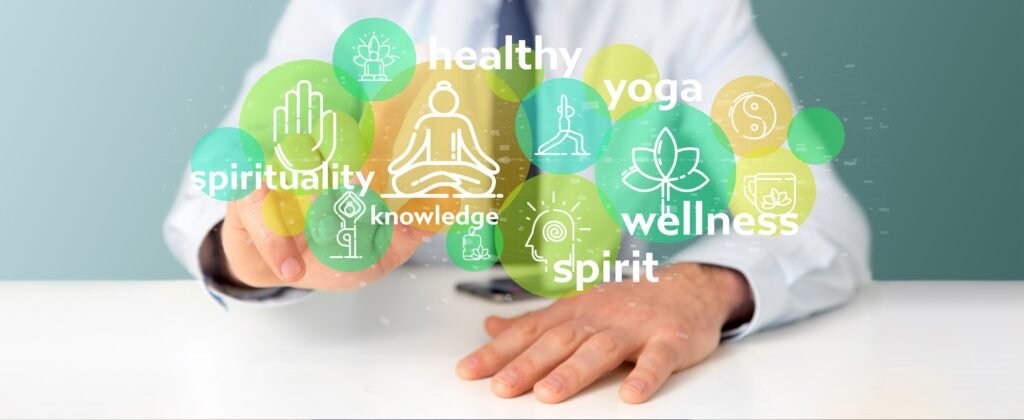
Rajeev Nayan, IOCL
nayanr@indianoil.in

“No one saves us but ourselves, no one can, and no one may. We ourselves must walk the path. Health is the greatest gift, Contentment the greatest wealth.” —
Gautam Buddha
Buddhist teachings also say that happiness can be achieved through physical and mental well-being.
Now, the question is how to make this Buddha quote practical. Which will certainly make our lives blissful, purposeful, and more productive in any walk of life.
Here comes into play the concept of Workplace Spirituality, Mindfulness, Strong sense of purpose and the idea of living in the present.
Spirituality
Let us understand spirituality from this Gautam Buddha Story.
The Nature of the Ocean
One day, a curious disciple approached the Buddha and asked, “What is spirituality?”
The Buddha replied, “Spirituality is diving into the ocean. It is about experiencing the depths of existence, understanding your true nature, and merging with the essence of all things. It requires courage and awareness, for it is not bound by rules or rituals. It is a personal journey, unique to each individual.”
The disciple pondered this and asked, “How do we know when we are being spiritual?”
The Buddha replied, “When you stop seeking the shore and begin to embrace the ocean as it is—its waves, its depths, its vastness—then you are spiritual. It is when you no longer look outside for answers but turn inward and realize that the entire ocean exists within you.”
The Lesson:
This story teaches that spirituality is an inner journey focused on self-realization, mindfulness, and connecting with the essence of life. Spirituality transcends boundaries and rituals, inviting individuals to experience truth directly. It encourages one to explore their inner world and discover the profound unity of existence.
Workplace Spirituality
Workplace spirituality involves the effort to find one’s ultimate purpose in life, to develop a strong connection to co-workers and other people associated with work and to have consistency (or alignment) between one’s core beliefs and the values of their organization. — Mitroff & Denton, 1999)
How to implement workplace spirituality?
1. Connect your work to your value system.
Pay attention to what the company stands for, who they are helping and how they are treating people inside and outside the company.
2. Look at things positively.
Learn to let go of negativity at work, whether it’s criticism from a colleague, people complaining about their jobs to you, or dealing with a disgruntled client, try to look for the positives.
Try to use positive words when you talk about the situation, analyze why it is making you feel in a certain way, and then move on from it.
3. Treat Others well.
Treat others how you would like to be treated, say please and thank you. Tell people you appreciate the work that they do. Pay others compliments.
4. Take some time for yourself.
Work on incorporating things like meditation, prayer, or mantras into your workday, depending on the sort of spirituality you practice.
5. Get to know your co-workers.
Who are the people that you work with? Would getting to know each other promote a more cohesive environment? Sometimes, people need someone to talk to, and if you sense that in a co-worker, then offer an ear.
The more you learn about your co-workers, the more you will be able to sympathize with them.
6. Put people first.
Make people feel valued. When people feel valued at work, they work even harder.
Put your customer first. Listen to what they want and figure out ways that you can help and connect with them even more than you do now. Nurture relationships with everyone in the business.
Mindfulness
Mindfulness is a state of active, open attention to the present. This state is described as observing one’s thoughts and feelings without judging them as good or bad.
Let us understand this from an anecdote.
The Arrow of Sorrow
One day, a disciple asked the Buddha, “Why do people suffer?”
The Buddha replied, “Imagine being struck by an arrow. This arrow causes pain. Now imagine being struck by a second arrow in the same place. The second arrow, caused by your reaction—your anger, worry, and fear—intensifies the pain.”
He continued, “In life, the first arrow is unavoidable; it represents the
challenges we face. But the second arrow is optional. Mindfulness helps you avoid this second arrow by accepting the moment without resistance.”
The Lesson
Mindfulness is the practice of observing without judgment, allowing the mind to settle and clarity to arise. It teaches us to respond to life with acceptance and wisdom rather than reacting with fear or attachment.
Sense of Purpose
A strong sense of purpose transforms ordinary tasks into meaningful contributions. It helps us see beyond immediate struggles and connect with a broader vision for our life. By aligning our actions with our purpose, we can lead a life of significance and fulfilment.
Let us understand this with the beautiful story of Stonecutter.
A traveller came across three stonecutters working on a large project. Curious, he asked the first worker, “What are you doing?”
The first stonecutter replied, “I’m cutting stones to make a living.”
The traveller asked the second stonecutter the same question. He responded, “I’m carving a block of stone to build a wall.”
Finally, the traveller asked the third stonecutter. He smiled and said, “I’m building a cathedral.”
All three men were doing the same work, but their sense of purpose shaped their experience. The third stonecutter saw his labour as part of something greater, giving his work deeper meaning and fulfilment.
Conclusion
We can conclude that by embracing spirituality, mindfulness, and a strong sense of purpose, we can lead more fulfilling, productive, and meaningful lives. Spirituality fosters inner connection and self-realization; mindfulness helps us live in the present without unnecessary suffering, and a strong sense of purpose transforms daily tasks into meaningful contributions. These principles, when applied personally and in the workplace, create harmony, resilience, and deeper satisfaction in all areas of life.
Posted in Health & Wellbeing | No Comments »
Recent Articles
- Navigating Leaves: Balancing Connectivity and Breaks in Today’s Workplace
- Boost Your Productivity with the Pomodoro Technique
- The Busy Professional’s Guide to Self Care
- Mental Health @ Work
- Mental Health and Well-being
- Positivity: Why you should make a New Year’s Resolution
- Get To Know About Nomophobia
- Fuelling Health: Energy of Our Body
- Keep Running
- Is Living Alone a Curse or a Boon? No, It is an Art
- Living with Meaning: Workplace Spirituality, Mindfulness, and Purpose
- Delivering Happiness during Pandemic
- HUMRAHEE: We are in This Together
- CHETNA: Personal Connect during COVID 19
- Ecosystem Restoration @ BPCL
- Leading the Way: HR Initiatives during Pandemic
- Living with the Invisibile
- Resurrection
- Health and wellness- From benefits to necessity
- Personal Strategies to Improve Well-being-CALM ki baaten
- Sustainability as Competitive Advantage
- Cold Feet Before the Meeting! Does it Sound Familiar
- 9 Common Workout myths debunked
- Positive Psychology – Mantra of Well-being
- Human Resource Development Through Sports At Workplace
- Nature Heals_How to boost your brain power with nature
- Success Story of Waste Segregation
- Occupational Health & Safety Bulletin on : Managing MSDs (Musculoskeletal Disorder)
- Gratitude: The Game Changer Antidote to All The Dis-eases
- Effective Time Management
- Watch out and act now Prioritizing Mental Health at Work
- Pursuing a Passion Outside of Work for mental wellness
- Prioritizing Mental Health at Work
- Health or Help – what will you prioritize?
- Digital Wellbeing – Way towards Mental Health
- Love yourself the way you want others to
- Kissa Kursi Ka
- Atychiphobia: Understanding the fear of failure
- Is Yoga = Meditation? Let’s solve it
- Overcoming Failure
- From Surviving to Thriving: Building a Culture of Employee Well-being
- Solid Waste Management -A dire necessity
- Sleep health: The cornerstone of Wellbeing
- Miracle of Stress
- Health & Wellbeing in the Organization
